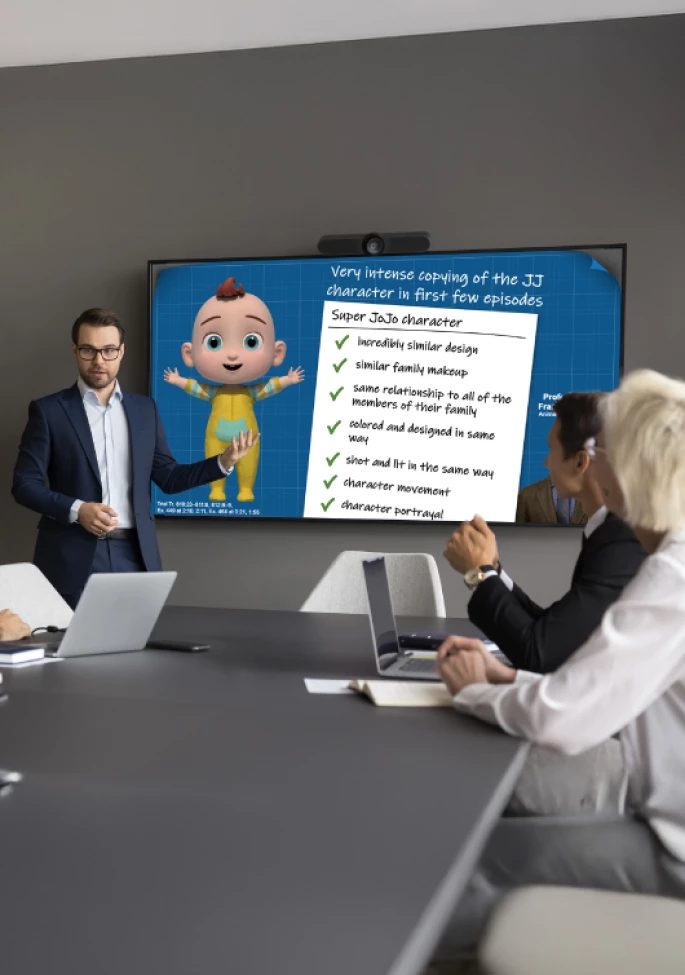Imagine The Scenario
Your star witness, an expert on the topic of prosthetic device microprocessors, has been on the stand for an hour discussing the history of prostheses, the nature of integrated circuits, and the two-part test for determining actual controversy. Thus far, they have relayed their testimony calmly and thoroughly. You are so pleased with their performance that your confidence concerning the trial outcome is beginning to swell. When you look over at the jurors, however, your optimism is dashed. One juror is rubbing her temples. Another has departed into a daze. And several others are grimacing. “Why aren’t they paying attention?” you wonder.
In response to being slapped with too much complex information, your jurors are showing signs of anxiety. When information overwhelms them, jurors exhibit a panoply of physical and mental responses. They might, for instance, shrink back in their seats, slump their shoulders, roll their eyes, and sigh loudly. They may feel insecure, frustrated, and even angry. Were it not unseemly courtroom behavior, jurors (and even judges) would audibly groan, “ugh.”
Helping Jurors Listen and Understand
If you are a trial lawyer who specializes in intellectual property cases, you have probably observed these sorts of responses. Jurors often do not understand the technology that is at issue in the case. Many of them possess little inkling about the workings of trademarks, patents, or copyrights. They understand they have a duty to reach conclusions based on evidence, but that obligation becomes impossible to fulfill when they find the evidence incomprehensible.
If you spot jurors exhibiting these signs of anxiety during trial, your IP case is in danger. Their responses indicate they have stopped listening to your argument, and thus, you have lost out on an opportunity to gain support for your client. Even if you eventually rouse these jurors back to attentiveness, the likelihood that they will side with your client has been diminished.
That is the bad news. The good news is that you can present complex material to jurors without triggering their malaise. It is not the material that is the problem, it is the teaching methods you and your witnesses are employing. This article reviews effective teaching techniques you can use in the courtroom. Employing them will make your jurors sit up, lean forward, listen, understand your case, and perhaps even enjoy jury duty.
Getting Jurors to “I Get It”
Good teachers understand how people learn. In order to teach jurors, you must understand that process too. Once these connections are made, people progress to the second stage of learning in which they incrementally add layers of new information to the knowledge they already solidly possess.
Here is another way to look at the learning process. It can be likened to plants growing on a garden lattice. The lattice is the solid base that enables plants to grow, just as familiar concepts act as a base that allows new ideas to bud for jurors. Slowly, plants sprout on the lattice, just as new knowledge begins to blossom for jurors. Eventually, a garden grows, and for jurors, this garden is your argument. By allowing new information to slowly take root in their psyches, you enable them to ultimately see your argument in its entirety. Jurors are then able to use this new information to properly perform their duty to carefully weigh the evidence in the case.
A Teacher’s Toolkit
The most effective classroom teachers use stories, analogies, and visual images to relay information to students. IP trial attorneys should employ these tools as well, and the specifics must be planned out and tested long before a witness takes the stand. Before getting into the nitty-gritty of the technology at issue in the case, jurors should be provided the overarching story of the case—who did what to whom, when, and why—and most importantly, jurors should always be provided with the reason why they should care. When the case involves particularly complex topics, analogies that relate to concepts with which jurors are already familiar should, at the outset of the learning process, be used in place of complex case facts. As well, use pictures to help jurors visualize invisible concepts. Interactive tutorials can be particularly helpful since they enable jurors to study images and information at their own pace. When the timing of events at issue in the case are important, timelines should be displayed.
Just as the methods teachers use depend on the subject matter they are presenting, the specific tools you will use will depend on the issues in your case. The best stories, analogies, and visual images will have five characteristics in common.
The Five Key Tools Will:
- Use real-world language
- Employ familiar concepts and ideas
- Leverage memorable imagery
- Intrigue the listener
- Facilitate incremental or paced learning
How Stories, Analogies, and Pictures Enable Comprehension to Take Flight
Let us say that you are defending an entrepreneur in a patent infringement case. In order to comprehend the evidence in the case, the jurors need to understand the concept of the enablement requirement for patent applications. Your expert witness might explain that the patent system has three primary disclosure requirements. These requirements consist of enablement, written description, and best mode. The enablement requirement compels the patent applicant to disclose the invention in a manner that allows a person of ordinary skill in the art to make and use the invention without an undue amount of experimentation. Your expert might add that enablement is the only disclosure requirement internationally mandated by the agreement on Trade-Related Aspects of Intellectual Property, or TRIPS.
While there would be nothing inherently faulty about the expert's explanation after hearing it, the jurors would be holding back their “ughs.” They would find the narration boring and barely comprehensible, and they would dread the prospect of spending the next few days sitting through similar testimony.
PUTTING THESE TOOLS TO USE
Now imagine how much more effective the expert would be if they started off discussing humans’ age-old desire to fly. “Every person has longed to fly at some point,” they might say. “Children try to fly off couches, adults dream of flying at night, and the Greek myth of Icarus centers on what happens when the joy of flying overtakes common sense.”
This story is appealing because it uses familiar concepts (Tool 2) and memorable imagery (Tool 3) to hook the audience.
The witness might go on, “People tried for centuries to build contraptions that would enable the dense-boned, unfeathered human mammal to fly. Many people died trying. Even the genius Leonardo da Vinci tried to come up with a flying machine. He eventually ended up declaring, ‘I have wasted my time.’”
By mentioning this famous artist, the expert will have again introduced subject matter with which jurors are familiar (Tool 2). And the fact that he tried yet failed at something will create intrigue (Tool 4) in jurors’ minds.
“None of these inventors could have received a patent under US law,” your expert could explain, “because none of them successfully ‘enabled’ their ideas.” They might add, “In other words, their ideas didn’t work.”
Now the expert would be using everyday language (Tool 1) to communicate with real-world people.
“But man’s quest for flight finally was achieved, on December 17, 1903,” they could continue, “when brothers Orville and Wilbur Wright built and, yes, successfully flew the first airplane. Unlike everyone before them, these two Ohio bicycle makers successfully ‘enabled’ the idea of a flying machine by making a machine that actually flew. As a result, the US Patent Office granted the Wright brothers a patent to protect their years of hard work from any imitators.”
When graphic displays are used, an already-interesting story could become riveting.
LAYERING INFORMATION
Suppose that during the expert’s testimony, jurors are shown how flying inventions evolved throughout the years. The progression and timing of inventions might be portrayed by building, bit by bit, new layers upon old inventions. As the witness talks about early attempts to fly, you might show Leonardo da Vinci’s sketches from the 1400s. You could then show pictures of aircrafts created by later inventors, such as the designs Sir George Cayley created in the early 1800s and the flying machines Claude Givaudan and Louis Blériot made in the early 1900s.
By creating a graphic that layers crucial information, you will have facilitated paced learning (Tool 5).
The expert’s story might end with a display of the Wright brothers’ patent application and a historical photo of their machine actually taking flight. And just like that, your jurors’ understanding of the concept of enablement will have taken flight as well. They will realize that it was not enough for previous inventors to possess good ideas. Only once the Wright brothers created a machine that could actually fly was their invention enabled. The invention was worthy of a patent because now someone with requisite skill could actually copy and use this invention.
Ready for Take-Off
Without ever hearing one complex case fact, jurors can come to understand the issues at the crux of your case. Stories, analogies, and visual displays will keep them interested in your presentations and enable them to painlessly accumulate a sound base of knowledge. With that base in place, they will then be ready to hear about the specific technology and other evidence related to your case. Chances are high, if you are willing to use effective teaching tools, jurors will not only understand your arguments, but they will also support them.








